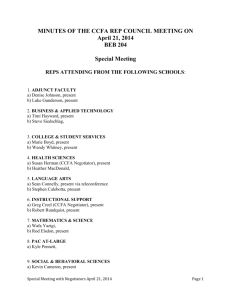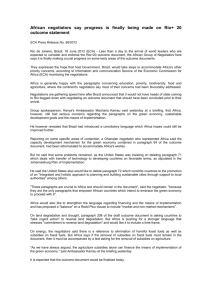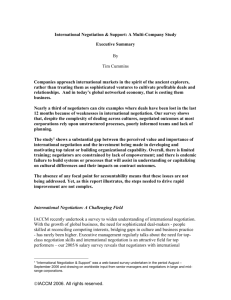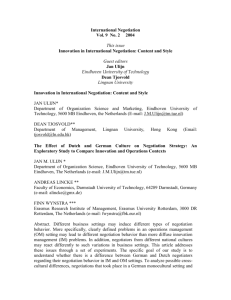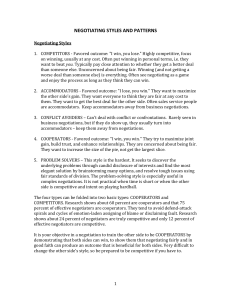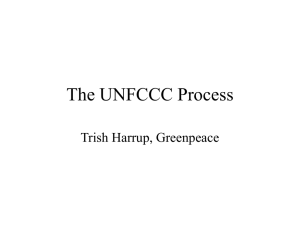Negotiation Nimbleness When Cultural Differences are Unidentified
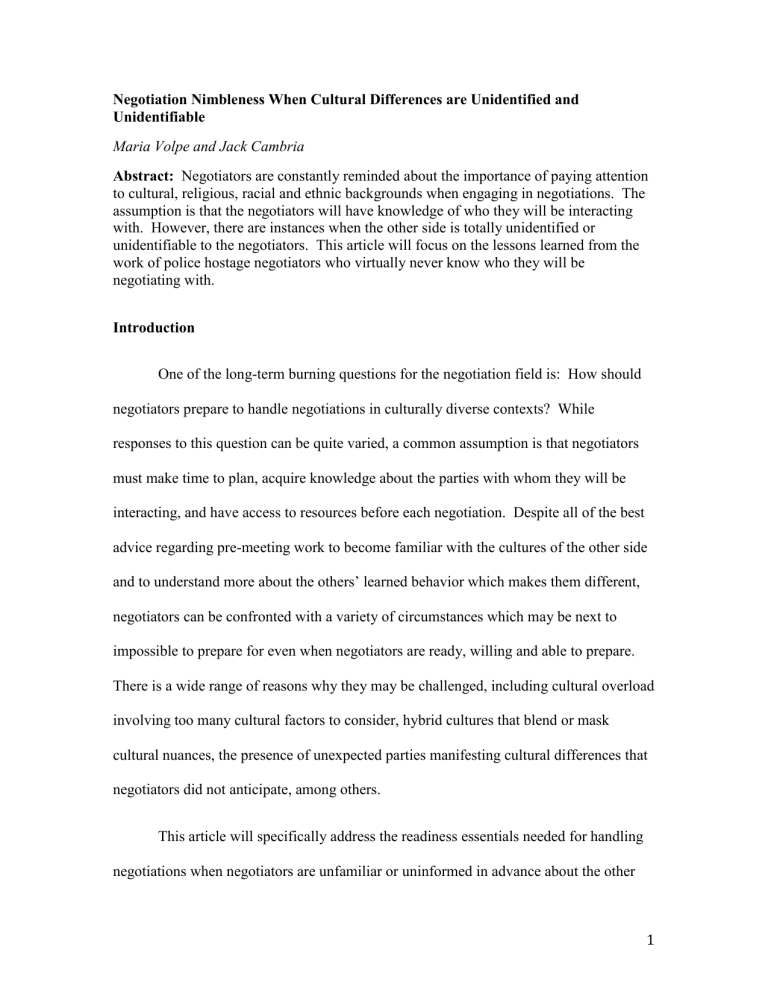
Negotiation Nimbleness When Cultural Differences are Unidentified and
Unidentifiable
Maria Volpe and Jack Cambria
Abstract: Negotiators are constantly reminded about the importance of paying attention to cultural, religious, racial and ethnic backgrounds when engaging in negotiations. The assumption is that the negotiators will have knowledge of who they will be interacting with. However, there are instances when the other side is totally unidentified or unidentifiable to the negotiators. This article will focus on the lessons learned from the work of police hostage negotiators who virtually never know who they will be negotiating with.
Introduction
One of the long-term burning questions for the negotiation field is: How should negotiators prepare to handle negotiations in culturally diverse contexts? While responses to this question can be quite varied, a common assumption is that negotiators must make time to plan, acquire knowledge about the parties with whom they will be interacting, and have access to resources before each negotiation. Despite all of the best advice regarding pre-meeting work to become familiar with the cultures of the other side and to understand more about the others’ learned behavior which makes them different, negotiators can be confronted with a variety of circumstances which may be next to impossible to prepare for even when negotiators are ready, willing and able to prepare.
There is a wide range of reasons why they may be challenged, including cultural overload involving too many cultural factors to consider, hybrid cultures that blend or mask cultural nuances, the presence of unexpected parties manifesting cultural differences that negotiators did not anticipate, among others.
This article will specifically address the readiness essentials needed for handling negotiations when negotiators are unfamiliar or uninformed in advance about the other
1
side’s unidentified or unidentifiable cultural information. Among those who routinely experience unexpected culturally diverse situations are hostage negotiators in the police context. They typically meet the other side when they respond to calls involving parties who are unknown to them (Volpe, Cambria, McHugh, and Honeyman, 2006). Not only do they not know who they will be negotiating with, hostage negotiators are further challenged by the fact that when they begin their interactions, they usually cannot even see the other party with whom they are attempting to interact. As such, hostage negotiators’ work, especially that of those in large, culturally diverse areas like New
York City, provides an optimal context from which to extract the basic ingredients of negotiating when cultural differences are unidentified and unidentifiable.
Cultural frameworks
Generally speaking, conventional wisdom suggests that negotiators should learn as much as possible about others’ culture before any encounter [e.g. see Blaker, et.al,
2002; Cogan 2003; Smyser 2002; Snyder 1999; Solomon 1999; Wittes 2005). An ongoing challenge, however, has been the identification of what in fact needs to be learned about culture since it is a very complex and nuanced concept, with varied definitions and understandings. The landscape becomes even more complicated when culture is viewed through the lens of the conflict resolution and ADR (Alternative or
Appropriate Dispute Resolution) fields of which negotiation is a key process.
Regardless of how the cultural component of any conflict is examined, historically, the systematic inclusion of culture in the conflict resolution or ADR context has been uneven (Avruch 2003). In his overview of the formative years of conflict
2
resolution and ADR theory with respect to the concept of culture, Avruch (2003: 352) has noted “how little attention ‘theory’ paid to the concept of culture and how practice, inspired by theory (or vice versa…), seemingly ignored the importance of cultural differences among parties (including third parties) as relevant to the sources or outcomes of a conflict or dispute.” Avruch (2003: 353) continues that it was not until the 1980s that Gulliver’s anthropological work on negotiation began to play a role in infusing culture into conflict resolution and ADR practice. Over the years, there is palpable evidence that interest in the culture concept has grown among theorists and practitioners in the conflict resolution and ADR fields. While understanding culture is now widely acknowledged as a significant topic for any conflict resolver’s education and training, it remains elusive. There is an implicit assumption that negotiators understand that cultural differences can play a significant role in negotiations, yet culture often means markedly different things to different people.
With full appreciation that culture can be both overestimated and underestimated, misperceived, and misunderstood, this article assumes that with respect to conflicts, cultural “fingerprints” are manifested both implicitly and explicitly in worldviews. It is a truism that peoples from different cultures process information through different lens, use language, gestures, voice tones, and symbols differently in the way they communicate, subscribe to different norms, values, and beliefs in everyday life, process emotions and feelings in ways that are recognizable to those with whom they share behaviors or attributes, and celebrate and grieve in ways that uniquely resonate with their traditions, heritage, and customs. Aspects of culture are so embedded in the everyday lives of people that they are often difficult to identify by those who are the carriers of the cultural
3
traces. The distinctions can be very subtle and embedded in lifestyles that it may take someone who is external to the group to notice. Furthermore, the qualities attributed to any specific culture can be difficult to distinguish from the mixing of other factors such as gender, class, age, status, etc. Perhaps, cultural differences are like those things that you know them when you see them, but otherwise may find them too hard to pin down.
When negotiators knowingly negotiate with others, especially when forewarned about others’ cultural background, they can prepare by drawing on a vast assortment of substantive knowledge to maximize their potential for comfort and success in undertaking their imminent encounters. There are myriad ways of preparing for such interactions. In fact, the “need to know” information ranges along a continuum from highly detailed, culture specific knowledge to very broad, culture generic knowledge.
At the culture specific end, negotiators can spend an extensive amount of time acquiring very detailed information about the other side, including nuanced substantive knowledge about the other side’s worldviews. Among the well known topics covered are history, climate, geography, music, art, foods, holidays, religion, clothing, politics, traditions, customs, norms, values, symbols, rituals, language, and other culturally defined behaviors and activities, all which influence the lens through which the world is viewed. The in-depth, detailed knowledge includes understanding subtle distinctions about the others’ verbal and nonverbal communication, how symbols, gestures, tone of voice and body language all fit together. For example, negotiators getting ready to interact with others can prepare by learning how greetings are exchanged in others’ cultures. Do they shake hands, embrace, salute, kiss on one side or both, kneel, genuflect, or bow? Additional fine tuning of cultural nuances when greeting others
4
includes such concerns as distance maintained from the other, amount of time spent talking, salutation, type of attire worn, who initiates the greeting, type and amount of eye contact, among others.
The discussion at the other end of the continuum where reliance is on generic principles is more complicated. One option is a simple formula which focuses on the use of “good commonsense” that emphasizes ways of acknowledging the other side. The thinking here goes as follows: “Just be respectful” or “just be a good listener” and one will be able to negotiate with anyone. While this oft-cited advice is easy to give, it still does not provide the significant “how to” information since respect and good listening need to be unpacked.
More complex understandings of generic approaches focus on conceptual frameworks that allow for ways to understand cultural groupings. Hall’s (1976) distinction between high context and low context cultures describes cultural differences between societies and provides a framework for understanding the impact of culture on communication.
High context cultures are relationship sensitive where relationships between people tend to be close, there is a strong sense of tradition, rituals, and history, and intermediaries play an important role. Information is understood without much need for clarification, people tend to know what each other thinks, meanings of what gets shared can be left unstated, and nonverbal behavior is used extensively to convey meanings. On the other hand, in low context cultures, greater emphasis is placed on the role of the individual in directly handling situations, shying away from rituals and favoring goal oriented strategies. Communication is straightforward with reliance on explicit statements to express behavior and convey information.
5
Another well known generic cultural framework constructed by Hofstede (1980) is based on research in more than 50 countries. To understand cultural differences,
Hofstede identified five main dimensions that reflect dominant value systems, including small versus large power distance, uncertainty avoidance, individualism versus collectivism, masculinity versus femininity, and long-term versus short-term orientation.
Hofstede’s collectivistic dimension mirrors Hall’s high context culture and his individualistic dimension tends to mirror the low context culture.
The application of any of these generic frameworks can be tricky. They provide generalizations of cultural differences for an entire society or culture rather than characterizations of individuals or subgroups. For example, the United States as a whole is characterized as individualistic, but an individual American may be collectivistic. A family unit within the United States is likely to be high context, but the United States is characterized as low context.
Cultural Competency for Negotiation Nimbleness When Interacting Across
Cultures
With ever-changing demographics, worldwide migration, and increasing globalization, the next generation of negotiators will succeed only if they are culturally nimble. This raises a key question, What do negotiators need to know in order to be sufficiently culturally competent when the cultural world of the other is unidentified or unidentifiable? This shifts the conversation from aiming to master cultural specifics to one that seeks to find ways to cope beyond “borders.” Hostage negotiators are not expected to become experts about all the cultures that they encounter. There is too much
6
uncertainty and too many groups to even imagine cultural competency in the more traditional sense. Nonetheless, they are expected to be sufficiently culturally competent to handle a wide range of culturally diverse situations. How best to prepare for this kind of scenario? Useful guidance comes from Bowling and Hoffman’s work on Bringing
Peace Into the Room where they have identified three stages of development for mediators. The first stage involves acquisition of techniques when practitioners learn skills, the second stage involves deeper understanding about how and why the mediation process works, and the third stage involves an awareness of how one’s personal qualities impact on the process. A parallel framework for negotiators would focus on the need to acquire techniques and understand why and how the negotiation process works. It would also stress the importance of addressing the influence of personal qualities on the negotiation process. While personal qualities are always significant in a negotiation process, they can be particularly important when handling cultural differences.
From the hostage negotiators: lessons learned
In many ways, the ingredients of negotiating with hostages are like all other negotiations. The hostage negotiators thoroughly prepare for their job as negotiators and pay careful attention to the context within which they are negotiating. However, a major difference is that their negotiations are for the most part with the unknown (Volpe,
Cambria, McGowan, and Honeyman 2006). Not only are those on the other side unidentified and unidentifiable in advance, usually, these individuals are not observable to the hostage negotiators when the negotiations are in progress. Moreover, since hostage negotiators are usually not the first responders, they more often than not meet with the parties after some assessment and perhaps even after some preliminary interactions have
7
already occurred between the responding officers and those involved in the hostage situation. By the time the hostage negotiators enter the scene, the police officers who responded initially, have often preliminarily diagnosed circumstances which they determine require a different kind of intervention than what they would be able to undertake as part of their routine rapid response approach. Some of the circumstances they have found which are clues that hostage negotiators are better suited include holding one or more individuals against their will and more often than not, the use of physical force and perhaps even weapons. From the perspective of the responding police, time and talking skills expertise are needed in order to engage in the ensuing interactions.
Depending on the situation, negotiations can go on for extended periods of time and responding police officers typically cannot spend long hours or, in some instances, days to one police call.
Given that hostage negotiators do not know who they will be negotiating with before or during the negotiations and are handed a situation that was already assessed by others, what do they look for to maximize the effectiveness of hostage negotiators’ ability to manage unidentified or unidentifiable culturally diverse situations? The first police hostage negotiation team, which was started in 1973 in one of the world’s most culturally diverse cities, namely New York City, provides an opportunity to understand how hostage negotiators are prepared to negotiate when cultural differences are involved. In a recent article, Cambria (2006), who is the current commanding officer of the NYPD hostage team, has distinguished between theory and practice. He notes that “The strategy of trying to pair the right set of negotiator-hostage-taker through ethnic or religious background, gender, social culture or sub-culture dynamics may have its place
8
in theoretical concepts, but in practice, the main concerns are the two individuals involved (negotiator and hostage-taker) and the rapport developed between them, regardless of individual background.” While the formula for intervention here may defy some of the conventional wisdom regarding mirroring of intervener with party, in fact, there are lessons to be learned for those experiencing situations where they have no specific or advance information about the other side’s culture.
For hostage negotiators, two significant ingredients, selection and training of the officers are crucial and inextricably linked. In order to staff the negotiation team, the search begins by recruiting members from within the existing pool of seasoned officers who have been trained and evaluated as patrol officers. In fact, before anyone can be considered for the hostage team of the New York City Police Department, one must have been an officer for a minimum of twelve years and have achieved the rank of detective.
As Cambria (2006) has noted, “Applicants meeting these criteria usually possess extensive experience in various field assignments from which to draw, and, by default, finds him or herself in the desired age group (at a minimum of thirty-four years old).
This age group usually ensures that an applicant has experienced the emotions of love and being disappointed or hurt in love, has known success, and perhaps most importantly, has known failure.”
As knowledgeable members of the department, hostage negotiation officers will have had an opportunity to learn about general police policies and practices, and to acquire first hand experience in applying them to a wide range of situations involving people in crises.
Hence, at the point they are eligible for the hostage negotiation team, they will have been tested and tried. Their policing records will have been established and they
9
will be well known by their professional peers, both as officers but also as people. They are older, more experienced, and are knowledgeable about the ebbs and flows of life including a variety of emotions, feelings, trials, and tribulations. Of particular note, they will have become familiar with the vast diversity of the population they service on a daily basis and acquired a feel for the different peoples through their work on the streets and responses to calls for assistance in the people’s homes.
Once officers have met the substantive knowledge criteria, they must manifest personal qualities that are important for interacting in emotionally charged situations regardless of who is on the other side. They need to be aware of themselves, remain calm in the midst of very stressful and emotional situations, able to readily establish relationships with strangers through verbal and nonverbal communication, and to be inquisitive. Central to the hostage negotiators’ work is active listening and elicitive questioning, both important in order to operationalize the motto for the New York City hostage team, “talk to me.” By asking the kinds of questions that encourage others to open up and talk, the hostage negotiators are imparting important signals to those who they do not know, but must communicate with. When they do not recognize or understand something that is being shared, they ask the hostage takers to elaborate. The officers must perfect the qualities that show respect for others. Of particular importance here are patience and a sense of timing. Since hostage negotiators have a long personal history in the department, in addition to any job interview, such personal qualities will have been observed formally and informally over the years. Overall, the years of training on the job which help to assemble the substantive knowledge and the selection process which seeks knowledgeable police personnel are inextricably linked.
10
To maximize their success, hostage negotiators need to be able to be code switchers, understand and contain their own cultural trappings, and work with the unidentified and unidentifiable cultural context of the others. Despite the amazing array of cultures they will come in contact with, they need to be able to use the generic skills of active listening, elicitive questioning, patience and timing. When they experience something unusual that suggests the need to gain additional knowledge, they need to ask more and more questions. Additionally, hostage negotiators make use of cultural experts.
While this can be daunting in the middle of a stressful negotiation, the hostage negotiators typically draw upon the vast resources within the law enforcement community and beyond. They can readily tap language, religious, cultural and other experts to assist them in their communication with the hostage takers.
For negotiators in other contexts, the lessons learned include the reminder of how important subject matter expertise is along with the skills associated with the context within which one is negotiating. For instance, hostage negotiators are aware that their interactions occur within the boundaries of a legal system. In situations where abusive relationships are acceptable in a particular culture, such would not be acceptable in the
United States.
In dealing with the unidentified and unidentifiable cultural qualities, one’s own personal qualities are crucial. Being able to quickly identify that something is different and adjust accordingly is crucial. In some instances, it may mean asking questions of the other party, in other instances, in means reaching out to experts to help enlighten one’s interactions.
11
There are no simple solutions or easy answers regarding how best to prepare for negotiations when cultural differences are unidentified or unidentifiable. Among the questions raised are the following: How does the hostage negotiator make a paradigm shift from his/her own ethnocentric or dominant cultural ways to enter the world of others? Is there such a thing as a cookie cutter approach that enables negotiators to be ready for all cultures without having knowledge of any specific culture? Are generic approaches reflective of the dominant culture? Perhaps one of the most daunting challenges for the hostage negotiators is the perceptions of others toward the police.
Conclusion
The teaching of negotiation has been dominated by culture specific information.
As people across the globe mix with each other, the prospect of getting to know specifics about everyone one encounters will diminish. Nonetheless, encounters will occur and negotiators need to have ‘foolproof’ guidance for interacting with anyone. The hostage negotiators provide valuable lessons for the next generation of negotiators who will need to be more nimble in handling unidentified and unidentifiable cultural issues.
References
Avruch, K. 2003
.
Type I and Type II Errors in Culturally Sensitive Conflict Resolution
Practice. Conflict Resolution Quarterly . 20: 351-371.
Blaker , M., Giarra , P. , Vogel, E. 2002. Case Studies in Japanese Negotiating
Behavior. Washington, D.C. : United States Institute of Peace Press. .
12
Bowling, D. and Hoffman, D. 2003. Bringing Peace Into the Room: How the Personal
Qualities of the Mediator Impact the Process of Conflict Resolution. San Francisco:
Jossey Bass.
Cambria, J. 2006. Do Ethnic, Religious, and Cultural Backgrounds Impact Hostage
Negotiations? Citizen Culture, 46-48.
Cofman Wittes, T., ed. 2005. How Israelis and Palestinians Negotiate: A Cross-Cultural
Analysis of the Oslo Peace Process. Washington, D.C. : United States Institute of Peace
Press.
Cogan, C. 2003. French Negotiating Behavior: Dealing with La Grande Nation.
Washington, DC: United States Institute of Peace Press.
Hall, E.T. 1976. Beyond Culture, New York: Doubleday
Hofstede, G. 1980. Culture's Consequences: International Differences in Work-Related
Values. Beverly Hills, CA: Sage.
McGoldrick, M., Giordano, J. , Garcia-Preto, N. eds. 2005. Ethnicity and Family
Therapy, Third Edition. New York: Guilford Press.
Smyser, W.R. 2003. How Germans Negotiate Logical Goals, Practical Solutions.
Washington, DC: United States Institute of Peace Press.
Snyder, S. 1999. Negotiating on the Edge North Korean Negotiating Behavior. Herndon,
Va.: United States Institute of Peace Press.
Solomon, R. H. 1999. Chinese Negotiating Behaivor: Pursuing Interests Through ‘Old
Friends’. Washington, DC: United States Institute of Peace Press.
13
Volpe, M. R., Cambria, J. J., McGowan, H., and Honeyman, C. 2006. Negotiating with the Unknown in Schneider, A. and Honeyman, C. The Negotiator’s Fieldbook
Washington, D.C.: American Bar Association, 657-665.
14

